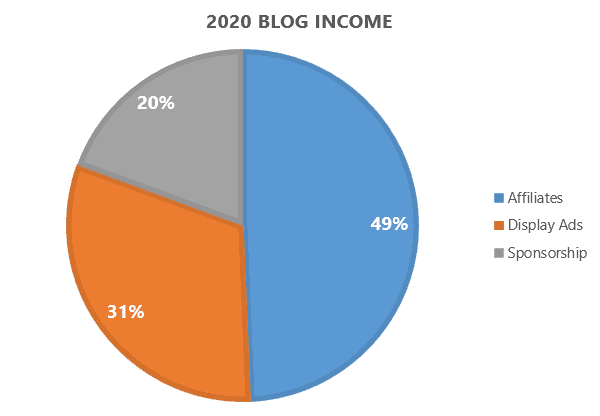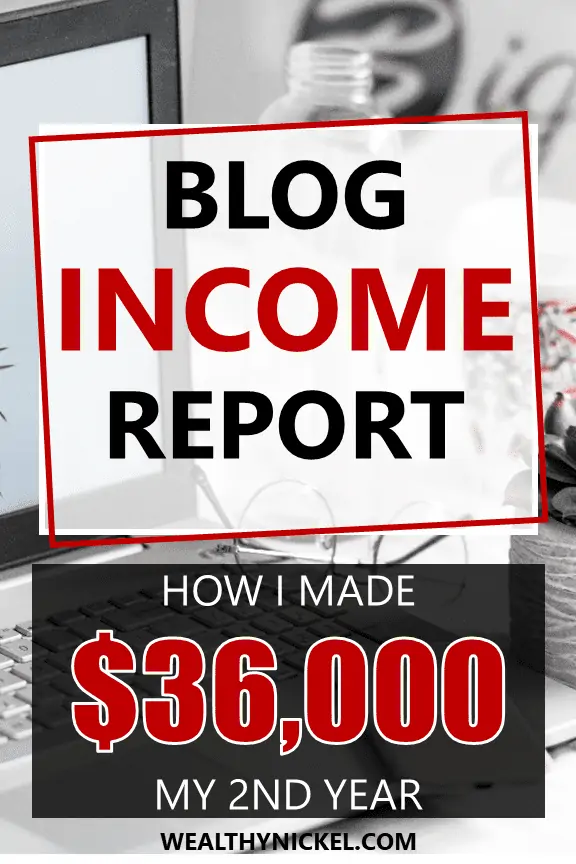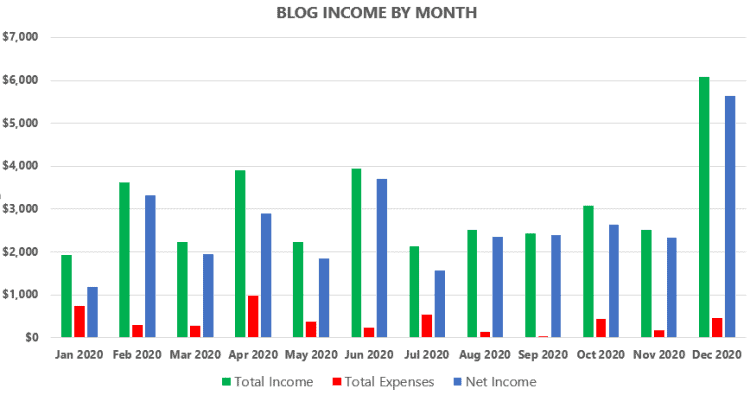The year 2020 was quite the roller coaster for my second full year of blogging.
But in the end, it was a year of huge growth and change for the blog.
It’s a little weird talking about blogging on my blog. Sure, there are plenty of “blogs about blogging” out there that want to sell you all kinds of secrets on how to rank #1 on Google and make $100,000 a month.
But that is not my goal. I promise I don’t have a course to sell you or “secrets” to share if you join my Facebook group.
Why Write a Blog Income Report?
One of my favorite things to talk about is making extra money, specifically through side hustles. So there is some intersection between the side hustle project that is my blog and personal finance.
Plus, while I’ve highlighted the trajectory and success of what I would consider a mega-blogger who made $400k+ in a year, I thought it might be instructive to show you what blogging looks like for a normal guy writing on the side of his day job and learning things as he goes.
Blogging can be a great side hustle to earn some extra income, but you have to be patient, and be prepared to put in a lot of work before you ever see your first dollar of profit.
What follows are some of the highlights of my second year blogging:
- Lessons learned
- How I more than 10X’d my income
- My biggest failure of the year
Year Two Goals for Wealthy Nickel
If you read my 2019 Blogging Income Report, I documented my first year blogging and set some goals for 2020.
As a quick summary, in Year 1 I grew from 274 pageviews a month to a little over 30,000. I earned a little over $2,000 and netted $700 after expenses.
Not bad for a guy with a brand new blog and no experience. But it was a lot of hard work, and my hourly pay rate was waaaaaaay below minimum wage.
For my second year, I wanted to scale up my traffic and income, while hopefully putting in about the same amount of time.
I had three main goals for my second year, and they were pretty simple:
- Consistently get 50,000 pageviews per month
- Double my organic search traffic
- Make $10,000 net profit
I wasn’t exactly sure how I would get there, but I planned to keep my pace of publishing one new post per week and doubling down on my traffic strategies.
While I wildly exceeded some of my goals, I failed on some of the basic execution. But more on that later…
Side Note: My first income report was based on my first 12 months blogging (October 2018 – September 2019). This income report is based on my second calendar year blogging (January 2020 – December 2020).
I find it easier to set and track goals by calendar year. That means there are 3 months that have fallen into the void, and will never be spoken of again. Don’t like it? Tough cookies. My blog, my rules!
Blog Growth Strategies
I wrote at length about my blog growth strategies in my Year 1 update. While I mostly stayed consistent with my focus of building traffic through organic search and Pinterest, I did increase my focus in other areas as well.
The array of options for growing an audience is dizzying, and I knew of bloggers having success with every one of them.
- YouTube
- Organic search (SEO)
- Guest posting
- Backlink building
- Email outreach
- Etc/etc/etc
Unless blogging is your full-time job, you can’t possibly focus on all of these at once. For me, I focused mainly on organic search and Pinterest, while adding in a bit more guest posting/backlink building in Year 2.
1. Google Search (SEO)
It is not easy to rank a brand new blog in Google. It can take 6 months or more before Google even knows you exist.
My search traffic was on the upswing going into my second year, but I plateaued and haven’t figured out yet how to break into the next level.
In 2020, Google seemed to be constantly toying with its algorithm, and it was hard to figure out what rules to play by. But overall, I tried to find relatively easy keywords that fit within my niche (I use Moz for keyword research) and tried to produce the best content I could for those keywords.
My best advice when it comes to Google is don’t overthink it. I was surprised at some of the keywords I was able to rank for, and equally surprised at some I was sure I would rank for that I did not.
In the end, Google does what Google does. Stay consistent, and you’ll end up with some winners.
2. Pinterest
I don’t really like Pinterest. I am not a creative person by nature, and I wasn’t really a user of the platform before I started a blog.
It’s also a lot harder to drive traffic through Pinterest than it was a few years ago (or so I’m told). If you think Google’s algorithm changes are a seismic shift, just try Pinterest for awhile and prepare to be blown away.
In 2019, I could pretty easily get a few thousand views on a new Pin (which would generate a few dozen clicks to the blog). In 2020, that pretty much dried up.
But somewhere in the inner workings of the algorithm, eventually some of my Pins got picked up and over time began to generate steady traffic. I would actually equate it more to a search engine than anything.
Be prepared to put in a lot of work and not see results for several months. Pinterest can be a uniquely frustrating platform, but if you throw enough stuff on the wall, some of it will stick. And it has paid off handsomely over the long term for me.
3. Guest Posting / Link Building
In my second year, I put a bit more focus into guest posting and link building. I put these two together because they are essentially one and the same.
Through networking with other bloggers and trying to present what made me unique against all the other bloggers out there vying for links, I was able to write a few articles for major publications like CNBC, The Ladders, and MSN. I was also able to collaborate with other bloggers and get some additional high quality backlinks through round-up posts or contributing a quote for an article.
There is no “easy” button for link building (despite the many products out there claiming otherwise). Building relationships with journalists and editors is a long process, but I hope to continue to get more opportunities this way.
Blog Income Report: Year Two Achievements and Fun Facts
When you’re in the middle of the day-to-day grind of pushing out blog posts, it can be hard to see the progress. But stepping back and looking over the past year, it’s been a fun ride!
1. My 3 Most Popular Articles Accounted for 40% of Overall Traffic (Again)
In my first year, I had 3 articles that drove 40% of my pageviews. With almost 160 published posts, I expected to diversify a bit in my second year.
Surprisingly, once again 3 articles made up almost 40% of pageviews, and 2 of them were the same as last year!
- The 3 Best Cash Back Apps That Make Me $500 Per Year (still #1 by a long shot)
- 11 Proven Ways to Make an Extra $500 a Month (the only new entrant for Year 2)
- Dave Ramsey’s Recommended Budget Percentages (down to #3 from #2)
While not my best traffic drivers, here are some of my personal favorites from 2020:
- Bookkeeping Side Hustle: How Nate Quit His Job to Become a Bookkeeper from Home
- Return on Equity (ROE): Real Estate’s Secret Formula for Success
- How to Turn $40K into $750K with Real Estate Investing
2. Averaged 53,000 Pageviews Per Month
My goal for 2020 was to average 50,000 pageviews per month, so I barely squeaked by on this one. But hey, a win is a win!
I was growing my pageviews pretty consistently until the pandemic put a damper on things. Between a general lack of interest in anything not related to a certain virus, and me taking a pretty long hiatus from the blog, my traffic dipped for quite awhile.
3. Pinterest and Google Accounted for Almost 70% of My Traffic
When I talked about my growth strategies above, I said that I focused the majority of my time on Pinterest and Google SEO.
Of my total sessions for the year, the combination of the two accounted for about 70%, up a little bit from last year. At least what I’m focusing on is aligned with my results!
Rounding out the top 5 are Direct (i.e., Google Analytics couldn’t figure out where it came from), Bing, and Email/Newsletter. The top 5 combined account for almost 90% of my traffic.
4. My Organic Search Traffic Tripled
My 2020 goal was to double my organic traffic (Google, Bing, Yahoo, etc.) from the prior year. So this was a definite win!
While my total search traffic has been trending in the wrong direction for the last 6 months or so, it’s still above where it was last year. This is partially my fault for not creating much new content in the second half of 2020.
Fun fact: The spike in April 2020 was due to an article I wrote about the first stimulus checks. It was quite the hot topic for awhile, but then obviously died out soon after. 2021 will have a similar spike in January. Can you guess what topic I wrote about? 😉
5. The Blog Made Over $36,000 in Revenue
Over the first 12 months, the blog earned $2,112 in revenue. In 2020, total revenue came in at $36,597. That’s a 1600% increase!
Of course, revenue is not profit. There are expenses to running a blog. Some of them are controllable, or optional. But since my main goal is long term growth, I’ve chosen to invest a decent portion of my profits back into the site.
In 2020, I incurred $4,764 of expenses, for a total net profit (before taxes) of $31,833. That still easily beat my net profit goal of $10,000 for the year.
The major jump in profit came as a pretty big surprise, and I’ll talk more about it in my lessons learned.
Here’s a general breakdown of my profit:
Income – $36,597
In my first year of blogging, all of my income came from affiliates.
In the second year, I was able to diversify somewhat, especially after being accepted into the Mediavine ad network.
Here is the breakdown for 2020:
- Affiliates: $18,058 – Commissions earned from link clicks to affiliate products such as Morning Brew, Survey Junkie, Roofstock, and others.
- Display Ads: $11,438 – Content and banner ads on the site. This is pretty much 100% controlled by Mediavine.
- Sponsorship: $7,101 – This includes sponsored posts and other promotions, and is mostly the result of working with a single brand multiple times over the year.
Expenses – $4,764
Hosting ($52)
I use Siteground for my hosting, and have been pleased with their service and performance.
Siteground is a little more expensive than Bluehost, which almost every blogger recommends (*cough* because they pay out the largest affiliate commission *cough*), but if you plan to grow your traffic to 10-20,000 pageviews per month you will quickly outgrow Bluehost. Siteground has plans that grow with you and won’t slow you down until you are well beyond 100,000 pageviews per month.
I originally signed up for 3 years of hosting, and 1 year of my domain plus privacy protection for $170. In 2020, I renewed my domain and privacy protection for the next year for $40.
Tailwind ($120)
I purchased a 12 month subscription to Tailwind, which is a Pinterest scheduling and analytics tool.
I credit a lot of my success with Pinterest to Tailwind, for the simple fact that it allows me to set-and-forget my Pins. I can create a batch of pins and schedule them to go out over the next several weeks. I still do some manual pinning, but one of the main success drivers with Pinterest is being consistent, and using Tailwind I make sure I am pinning fresh content every day.
If you want to check out Tailwind, you can get one month free using my referral link. If you sign up through my link, I will also get a free month 🙂
Email Marketing Platform ($583)
I’ve been using Mailerlite as my email marketing platform, which is free for the first 1,000 subscribers. I surpassed that quite awhile ago and have been paying for the 10,000 subscriber plan for most of 2020.
Even as a paid service, it is cheaper than most out there, and it has provided all the functionality I need such as list segmentation and automation sequences.
If you’re looking for a good email marketing platform, I’d definitely recommend it, especially if you’re just getting started (it’s free!)
Click here to try Mailerlite and get a $20 credit when you sign up.
Marketing and Research ($4,009)
The bulk of my expenses are investments back into growing the site.
I’ve tested a lot of different marketing ideas to attract new readers including giveaways, Facebook and Pinterest ads, and other paid services or tools. I consider this expense to be an investment in the future growth of the blog.
This category also includes membership dues to a blogging mastermind I am a part of called Money Mix Insiders. Being able to bounce ideas off of other bloggers and network is one of the keys to my success. While there is a cost to being a member, it has more than paid for itself in free tools, and growth strategies I never would have thought of on my own.
If you’re a beginning to intermediate blogger, I highly recommend the Insiders program to accelerate your growth.
Click here to check out Money Mix Insiders.
Accounting Note: For you accounting nerds, I am using cash-based accounting. So I don’t record revenue until I actually receive it in my bank account. This is different than most blog income reports, and is significant because there is usually a 30-90 day lag in getting paid for ad revenue or affiliate commissions.
For example, I just recently got paid for my monthly income from display ads 3 months ago. On the plus side, I pretty much know what my next few months of revenue will look like. I am currently owed almost $5,000 from various affiliates and display ads.
Year Two Lessons Learned
A lot happened in 2020. Some lessons carried over from the first year, but I learned some new ones as well.
1. Consistency, Consistency, Consistency
Be consistent. A lot of the things I’m doing now with 50,000 pageviews a month are the exact same things I was doing in the beginning with 300 pageviews a month.
Some of these things include:
- Publishing at least one new article per week
- Optimizing posts for SEO
- Creating and posting new pins on Pinterest regularly
- Looking for backlink opportunities
Some of these things I did for 6 months or more before I ever saw any benefit!
—
I wrote all of the above last year (except for adjusting the pageview number). In all honesty, I actually failed miserably at being consistent in 2020.
I didn’t write a single new blog post for almost 6 months (life and the pandemic got in the way). And you can see the effects of that in that it limited my growth.
But that leads to the next lesson…
2. Blogging CAN Be Passive
Even though I basically stepped away from the blog for 6+ months, traffic stayed relatively steady and so did my income.
Looking at the chart, can you tell when I was virtually absent from the blog? No? Me either…
So while I didn’t do a great job of growing my blog in 2020, the time and effort I put in last year paid dividends this year.
I certainly wouldn’t recommend setting your blog on autopilot forever, but it is comforting to know that if something happens in my life and I can’t be as consistent as I want to be, the blog will keep chugging along without me for awhile.
3. Blogging is a Team Sport
I always thought that bloggers sat in front of their computers, typed out posts, and waited for people to arrive at their site.
But the further I get into blogging, the more I realize it’s the same as any other business – who you know is at least as important as what you know.
I’ve been lucky enough to find a tribe of bloggers that are either at my level or a little ahead of me, and I’m part of a couple of “masterminds” of sorts. We help each other with questions, ideas of what’s working and what’s not working, and accountability to keep going.
As I mentioned earlier, my blog saw a rapid increase in success after joining the Money Mix Insiders mastermind. I would highly recommend it if you seem stuck and are looking to get to the next level.
As an introvert, I thought I wanted it to be just me and my computer, but as it turns out, the community I’ve found has been at least as rewarding as growing the site itself.
4. Focus on What Drives Results
The Pareto Principle, which states that 20% of what you do drives 80% of the results, certainly applies to blogging.
Due to the very limited amount of time I was able to dedicate to the blog in 2020, I had to really focus on what mattered. It was honestly quite surprising (and I’m sure somewhat lucky) how well it worked out.
For example, instead of posting a lot of new content, I went back and updated old content that could use a little boost.
I also focused in on one affiliate that was driving a lot of my revenue. I made sure to incorporate them into as many blog posts as I could and even ran social media ads to some of those posts. As a result, this one affiliate accounted for about a third of my total affiliate revenue.
By using the Pareto Principle, I was able to do more with a lot less and still get results. What worked for me may not work for you. Everyone’s strengths are different, as well as the opportunities presented. For me I let what was already working well guide me toward ramping it up into greater success.
Blogging Goals for Year Three
I don’t know if I’ll do another detailed report at the end of Year 3, but I do have some goals for my next 12 months:
- Consistently get 75,000+ pageviews per month – I barely made it to my 2020 goal of 50,000 pageviews per month and this is a 50% increase. Hopefully with a more consistent posting schedule in 2021 I can make this happen.
- Average 1 new blog post per week – Back to the basics. I wrote less than 10 new blog posts in 2020, which was a giant fail. I need to get back on track and produce more content.
- Make $50,000 net profit – To be honest, I was blown away I made $30,000 this year, and I would be happy to make that again. But what’s the point in setting goals if you don’t raise the bar a little?
- Implement one new special project – I honestly don’t know what this will be. An ebook? A course? An online Facebook group? I am still trying to figure out who my audience is and who I want it to be. I think this will help me niche down a bit more.
I love helping people discover personal finance principles for the first time, and I also find I enjoy talking about making money more than frugality. I also have experience building wealth through real estate, so a decent chunk of blog posts have been dedicated to that. Whatever I do, I want to keep producing quality content that truly helps the readers.
Whew…if you made it through all of that, you must either already be a blogger, or interested in starting a blog yourself!
READ NEXT: Blog Progress Report: My First Year By the Numbers
If you’re still reading, leave me a comment below on how your blog is going, or what your plans are for your blog this year. I’d love to connect!
Andrew Herrig is a finance expert and money nerd and the founder of Wealthy Nickel, where he writes about personal finance, side hustles, and entrepreneurship. As an avid real estate investor and owner of multiple businesses, he has a passion for helping others build wealth and shares his own family’s journey on his blog.
Andrew holds a Masters of Science in Economics from the University of Texas at Dallas and a Bachelors of Science in Electrical Engineering from Texas A&M University. He has worked as a financial analyst and accountant in many aspects of the financial world.
Andrew’s expert financial advice has been featured on CNBC, Entrepreneur, Fox News, GOBankingRates, MSN, and more.









Congrats on the growth Andrew, that’s a big jump! It’s great to see that you’re having success.
Thanks Marc! It was a good year. Don’t know if I’ll be able to repeat in 2021, but learned a lot!
You are truly killing it. Very few full time bloggers make that kind of income and you are still on the growth curve, just getting started. I just blog for fun, no social media, no ads, no products and no SEO and I do not plan to change any of that. I have enough readers to encourage me to produce content and that’s all I ever wanted out of blogging. But I do admire people who can monetize blogging successfully. For one thing those of you who are profitable are generally very gifted writers and communicators and produce a lot of original content, which is fun to read. Congratulations on being all that.
Thanks Steve, appreciate the compliment! I admire people like you who do it for free. At this stage of my life, the income helps me toward my financial independence goals. Hopefully one day I can write about whatever I (and my readers) want and stop caring what Google thinks!